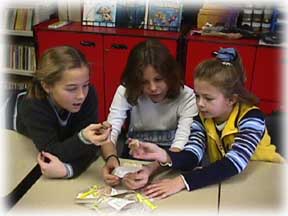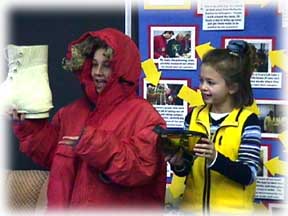
Overview
Visiting the classroom probably is one of the most common outreach paths; it is quick, and requires little preparation. It potentially also has the lowest impact in the long term for the students (the reason we do this) - the scientist shows up, talks about research for an hour, and then disappears. The students never see the researcher again, and the information often is not integrated into their framework of knowledge. Does this mean don't do it? NO! Make your classroom visit count!
There are three things you want to share when you head into the classroom:
You are a valuable asset in the classroom; you are the specialist, you are the visitor, and you are the interesting diversion for the day. Ideally, you want to present information and stimulate thought and discussion with your audience. This can be done with all ages.
Occasionally, researchers don't want to present the science content because it is "boring" or "too difficult for the audience to understand." Don't buy into this; by not presenting your science, you are adding to the negative public attitudes about science and doing a disservice to everyone involved. Invest the time to make sure the relevance, interest, and excitement of your research comes through!
Spend some time at the school and with the teacher. Treat the teacher as the professional he/she is - this is common sense, but not always acted upon. Investigate what is happening in classrooms today - it is very different from when you were in school - and this is not necessarily a bad thing.

Photo by Betty Trummel, Husmann Elementary in Crystal Lake, Illinois.
Suggestions
In Preparation:
When You Are Presenting to the Class:
Resources
All researchers pondering educational outreach should become familiar with the National Science Education Standards (http://books.nap.edu/ ). Published by the National Research Council (1996), the Standards provide a systemic vision of science education and education reform. They offer a guide for the concepts students should be tackling at a given age level. The Standards also provide guides for teacher professional development and student assessment and a vision for science education programs. Three underpinnings to the Standards that should make scientists happy:

Photo by Betty Trummel, Husmann Elementary in Crystal Lake, Illinois.
For ideas about classroom activities:
- Teachers Experiencing Antarctica and the Arctic (TEA; ../) Activities created by TEA teachers.
Into the Arctic (http://arcss.colorado.edu/arcssed/start.htm) A site designed to offer instructional materials and activities for teachers to use in the many contexts of their daily teaching routine. Information and activities are divided into four sections: Climate, Climate Change, El Niņo and the Greenland Ice Sheet Project 2.
Polar Connections (http://www.nsf.gov/od/lpa/nstw/98/start.htm) The National Science Foundation's 1998 National Science & Technology Week focused on polar science. The Web site is available; hardcopy packets are hard to find.
New ideas, suggestions for changes, recommendations for additions, etc. always are welcome and can be mailed to:
There's No Place Like Home....
